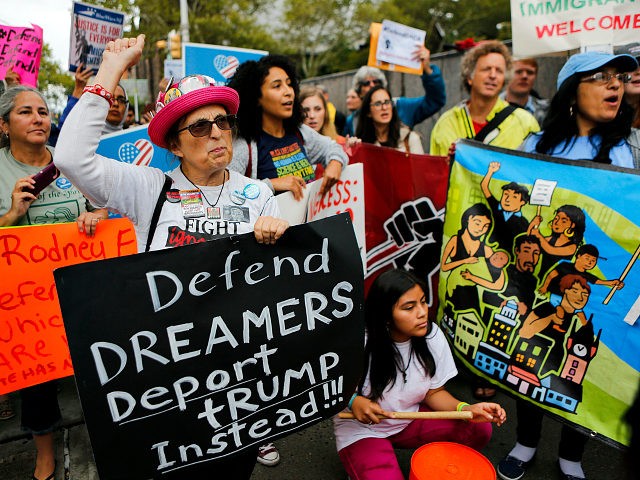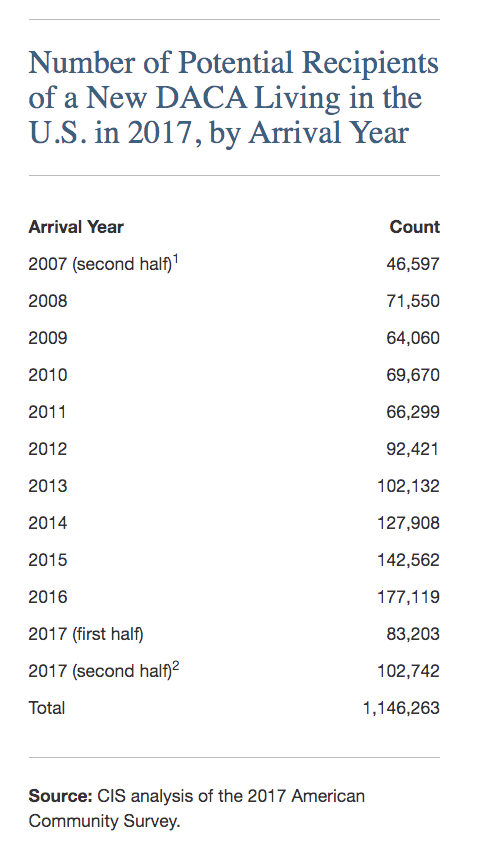The population of so-called “Dreamer” illegal aliens has risen by at least one million since President Barack Obama announced his Rose Garden DACA amnesty for child migrants who entered the United States before 2007.
“As of 2017, we estimate that the United States has more than 1.1 million illegal immigrants who arrived before the age of 16 but are not eligible for the current DACA program because they arrived after the [2007] cutoff time,” said a November 18 study by Jason Richwine, a demographer who works with the Center for Immigration Studies.
Many more children were brought over the border in 2018 and 2019 because border defenses were paralyzed by the alliance of Democrats, immigration lawyers, judges, and cheap-labor Republicans. In part, the rush of foreign parents with children came because the migrants saw the Democrats offering the huge prize of citizenship to the prior wave of DACA illegal aliens.
According to Richwine:
[In 2018 and 2019], border apprehensions have increased dramatically, so did the predicted number of childhood arrivals whom we would expect to observe in the ACS [the Census Bureau’s American Community Survey]: 227,000 in 2018 and a remarkable 437,000 in 2019, according to the model … it is plausible that the pool of potential DACA recipients has grown enormously in the last two years, as the number of family units apprehended at the border certainly has.
Any amnesty would lower Americans’ wages by raising the labor supply, bump up Americans’ rents by growing the population, further pack Americans’ blue-collar schools with migrant children, and continue to shift the focus of American politics away from Americans’ priorities.
Richwine’s data suggests a DACA amnesty could include nearly four million youths and children — which is roughly equal to the number of young Americans who will turn 18 this year.
In June, Democrats passed their “Dream and Promise Act” amnesty, which was low-balled by supporters as an amnesty for 2.5 million illegal aliens. That number included non-DACA migrants who are facing a legal end to their “Temporary Protective Status” (TPS) and “Deferred Enforced Departure” (DED) programs.
For example, the Washington Post downplayed the illegality of the migrants and their numbers, saying in a headline that “House Democrats propose offering 2 million immigrants the chance to apply for U.S. citizenship.”
One pro-migration group estimated the beneficiaries would total 2.7 million illegal aliens and TPS migrants:
[The Migration Policy Institute] estimates that 2.3 million DREAMers would be eligible for conditional legal status under the bill, and 429,000 TPS and DED holders could apply immediately for legal permanent residence (also known as getting a green card). All told, MPI estimates that HR 6 would put slightly less than 2.7 million of the nation’s estimated 11.3 million unauthorized immigrants on a path to a green card.
That MPI estimate excludes the one million-plus population identified by Richwine — even though the Democrats’ bill explicitly bars the deportation of the younger-than-DACA illegal aliens. According to the MPI:
The measure would also block the deportation of anyone under age 18 who entered the country at least four years before the bill’s enactment, under the assumption that they would become eligible for conditional status as they further their education. In doing so, the measure would also offer work authorization to these unauthorized immigrant minors, as it would to anyone applying for legal status under HR 6, while the application is pending.
Moreover, the Democrats’ bill would prevent the deportation of anyone — including recent arrivals and suspected criminals — until officials could show they are ineligible for the broadened amnesty. The MPI said:
the bill would make people ineligible for deportation if they could show that, at first glance, they were eligible for legal status under HR 6 or through other existing channels, such as asylum or cancellation of removal. (Cancellation of removal is available to unauthorized immigrants who have lived in the United States for at least 10 years; show good moral character; and who have a U.S.-citizen or lawful permanent resident parent, spouse, or child who would suffer extreme consequences if the applicant were removed.)
Moreover, any of the DACA amnesties would put the DACA illegal aliens on a track to citizenship — and so allow them to campaign for an amnesty of the illegal immigrant parents who brought them as children into the United States.
DACA legalization would also open up new channels of chain migration, although the annual inflow would not increase unless Democrats also voted to expand the inflow of roughly one million foreigners each year.
Immigration Numbers:
Each year, roughly four million young Americans join the workforce after graduating from high school or a university. This total includes about 800,000 Americans who graduate with skilled degrees in business or health care, engineering or science, software, or statistics.
But the federal government then imports about 1.1 million legal immigrants. It also adds replacement workers to a resident population of more than 1.5 million white-collar visa workers — including approximately one million H-1B workers and about 500,000 blue-collar H-2B, H-2A, and J-1 visa workers. The government also prints more than one million work permits for new foreigners, and it rarely punishes companies for employing illegal migrants.
This policy of inflating the labor supply boosts economic growth and stock values for investors. The stimulus happens because the extra labor ensures that employers do not have to compete for American workers by offering higher wages and better working conditions.
The federal policy of flooding the market with cheap, foreign white-collar graduates and blue-collar labor shifts wealth from young employees toward older investors. It also widens wealth gaps, reduces high-tech investment, increases state and local tax burdens, reduces marriage rates, and hurts children’s schools and college educations.
The cheap-labor economic strategy also pushes Americans away from high-tech careers, and it sidelines millions of marginalized Americans, including many who are now struggling with drug addictions.
The labor policy also moves business investment and wealth from the Heartland to the coastal cities, explodes rents and housing costs, undermines suburbia, shrivels real estate values in the Midwest, and rewards investors for creating low-tech, labor-intensive workplaces.
But President Donald Trump’s “Hire American” policy is boosting wages by capping immigration within a growing economy.
The Census Bureau said September 10 that men who work full-time and year-round got an earnings boost of 3.4 percent in 2018, pushing their median salaries up to $55,291. Women gained 3.3 percent in wages, bringing their median salaries to $45,097 for full-time, year-round work.


COMMENTS
Please let us know if you're having issues with commenting.